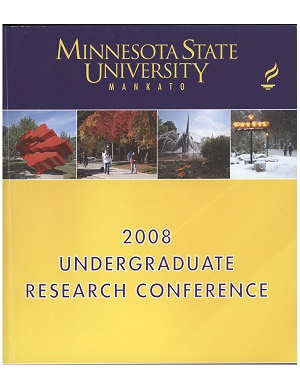Ultraviolet Radiation Screening Effectiveness of Three Coniferous Tree Species During Spring Thaw Events in Southern Minnesota
Location
CSU Ballroom
Start Date
21-4-2008 1:00 PM
End Date
21-4-2008 3:00 PM
Student's Major
Biological Sciences
Student's College
Science, Engineering and Technology
Mentor's Name
Christopher T. Ruhland
Mentor's Department
Biological Sciences
Mentor's College
Science, Engineering and Technology
Description
The persistence of evergreen foliage throughout the winter allows conifers the ability to photosynthesize during warm winter periods and early spring when water is available. Typically photosynthetic rates are low in coniferous species compared to their deciduous counterparts. The ability to photosynthesize in less-thanoptimal conditions may contribute to their annual net primary productivity. Coniferous foliage is exposed to high visible and ultraviolet (UV) radiation, desiccating winds and cold temperatures during the winter months in Southern Minnesota. We examined photosynthetic performance and UV-screening ability of three coniferous species (Pinus sylvestris, Picea pungens, Pinus strobus) on the campus of Minnesota State University from January to April 2008 with modulated fluorometers. Plants showed very little photosynthetic ability during extreme cold events (-4 to -18°C) with light- and dark-adapted yields averaging <0.10 over all sampling dates. Concentrations of chlorophyll and carotenoids (carotenes and xanthophylls) were much higher in P. sylvestris and P. pungens than in P. strobus. In addition, concentrations of UVabsorbing phenylpropanoids were 63% greater in P. sylvestris and P. pungens than in P. strobus. The increased concentrations of these compounds may be related to the decreased epidermal transmittance of UV in the former two species. However epidermal transmittance of UV was appreciable. Epidermal transmittance of UV averaged 35, 52 and 62% for P. sylvestris, P. pungens and P. strobus, respectively. We will continue to assess these parameters during the early spring and expect an increase in photosynthetic ability and a simultaneous reduction in UV transmittance as the season progresses and temperatures increase.
Ultraviolet Radiation Screening Effectiveness of Three Coniferous Tree Species During Spring Thaw Events in Southern Minnesota
CSU Ballroom
The persistence of evergreen foliage throughout the winter allows conifers the ability to photosynthesize during warm winter periods and early spring when water is available. Typically photosynthetic rates are low in coniferous species compared to their deciduous counterparts. The ability to photosynthesize in less-thanoptimal conditions may contribute to their annual net primary productivity. Coniferous foliage is exposed to high visible and ultraviolet (UV) radiation, desiccating winds and cold temperatures during the winter months in Southern Minnesota. We examined photosynthetic performance and UV-screening ability of three coniferous species (Pinus sylvestris, Picea pungens, Pinus strobus) on the campus of Minnesota State University from January to April 2008 with modulated fluorometers. Plants showed very little photosynthetic ability during extreme cold events (-4 to -18°C) with light- and dark-adapted yields averaging <0.10 over all sampling dates. Concentrations of chlorophyll and carotenoids (carotenes and xanthophylls) were much higher in P. sylvestris and P. pungens than in P. strobus. In addition, concentrations of UVabsorbing phenylpropanoids were 63% greater in P. sylvestris and P. pungens than in P. strobus. The increased concentrations of these compounds may be related to the decreased epidermal transmittance of UV in the former two species. However epidermal transmittance of UV was appreciable. Epidermal transmittance of UV averaged 35, 52 and 62% for P. sylvestris, P. pungens and P. strobus, respectively. We will continue to assess these parameters during the early spring and expect an increase in photosynthetic ability and a simultaneous reduction in UV transmittance as the season progresses and temperatures increase.
Recommended Citation
Gardner, Daniel M. and Christopher M. Gardner. "Ultraviolet Radiation Screening Effectiveness of Three Coniferous Tree Species During Spring Thaw Events in Southern Minnesota." Undergraduate Research Symposium, Mankato, MN, April 21, 2008.
https://cornerstone.lib.mnsu.edu/urs/2008/poster-session-B/6



